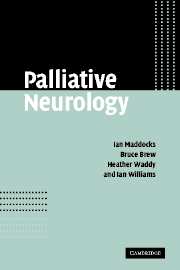Book contents
- Frontmatter
- Contents
- Foreword
- Note on drugs and abbreviations
- Section I Palliative Management
- Section II Major discomforts in advanced neurological illness
- Section III Major neurological conditions requiring palliation
- 1 Cerebrovascular disease: stroke
- 2 Demyelinating disease
- 3 Parkinson's disease and related disorders
- 4 Dementia
- 5 Amyotrophic lateral sclerosis (motor neurone disease)
- 6 Incurable Infections of the nervous system
- 7 Muscular dystrophy
- 8 Neuropathies
- 9 Huntington's disease
- 10 Cerebral neoplasms
- 11 Sequelae of traumatic brain injury
- Section IV Ethical issues
- Section V Appendices
- Index
9 - Huntington's disease
from Section III - Major neurological conditions requiring palliation
Published online by Cambridge University Press: 08 January 2010
- Frontmatter
- Contents
- Foreword
- Note on drugs and abbreviations
- Section I Palliative Management
- Section II Major discomforts in advanced neurological illness
- Section III Major neurological conditions requiring palliation
- 1 Cerebrovascular disease: stroke
- 2 Demyelinating disease
- 3 Parkinson's disease and related disorders
- 4 Dementia
- 5 Amyotrophic lateral sclerosis (motor neurone disease)
- 6 Incurable Infections of the nervous system
- 7 Muscular dystrophy
- 8 Neuropathies
- 9 Huntington's disease
- 10 Cerebral neoplasms
- 11 Sequelae of traumatic brain injury
- Section IV Ethical issues
- Section V Appendices
- Index
Summary
This neurodegenerative disease is inherited as an autosomal dominant, the genetic defect lying in the expansion of a CAG repeat on the short arm of chromosome 4. The extent of the expansion of the repeat determines the manifestations of the disease (where there are more than 40 repeats onset of the disease is certain, with fewer repeats there may be carrier status but no occurrence of the disease in that individual). Since finding the gene for Huntington's disease, it has become possible to identify those individuals who will develop the condition. That gives an especial poignancy to management, since persons so identified are often well aware of the future course of the disease with its devastating spectrum of movement disorder, psychiatric manifestations and cognitive impairment.
The symptoms of Huntington's disease usually appear first between the ages of 30 and 50 years, and progress slowly but inexorably, over a period of some 20 years or more. No known treatment prevents the disease onset or slows its progression. It is, of all diseases, one for which, from its earliest stages, palliation of symptoms is the only therapy; what needs to be considered is at what stage it can be accepted by patient and family that they are in ‘palliative care’.
The variable spectrum of decline in function over time can be arbitrarily divided into five progressive stages extending over many years:
The time of early diagnosis when full capacity is maintained.
…
- Type
- Chapter
- Information
- Palliative Neurology , pp. 186 - 190Publisher: Cambridge University PressPrint publication year: 2005



